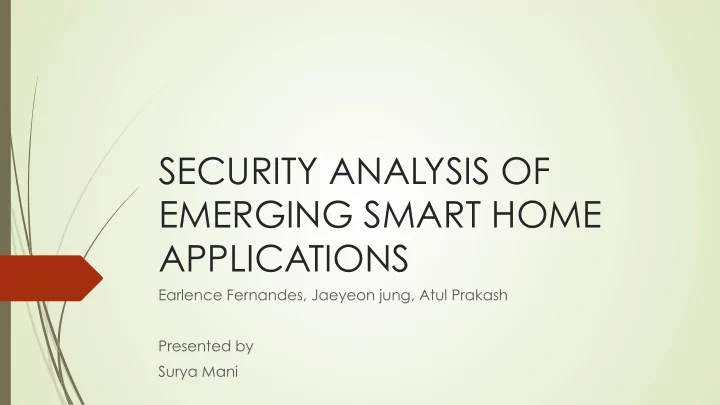

SECURITY ANALYSIS OF EMERGING SMART HOME APPLICATIONS Earlence Fernandes, Jaeyeon jung, Atul Prakash Presented by Surya Mani
Content ´ Motivation ´ Related Work ´ SmartThings-Big Picture ´ Security Analysis ´ Proof-of-concept attacks ´ Defense Mechanism
Motivation ´ Huge number of connected gadgets, systems and appliances that do a wide variety of different things. ´ Though it provides user with benefits, it also expose user to security risks
Related Work ´ A framework for evaluating security risks associated with technologies used at home- Denning ´ Device front ´ MyQ garage system, Wink Relay touch controller, Honeywell Tuxedo Touch Controller ´ Investigate the feasibility of causing physical harm through the explosion of CFLs through an exploited home automation system ´ Use Case : sharing smart devices with others ´ Protocol Front – Zigbee and Zwave protocol ´ Investigation on cause of over privilege due to insufficient API documentation and guidelines on different types of permission- Felt
IoT Paper ´ First in-depth security analysis of one such “smart home” platform that allows anyone to control their home appliances from light bulbs to locks with a PC or smartphone. ´ Demonstrate programming framework design flaws ´ Analyze protocol operating between SmartThings backend and the client- side web IDE ´ Remote attacks that weaken the home security system independent of specific protocol in use. ´ Evaluation of SmartThings capability model in protecting sensitive device operations
Smart Home applications
SmartThings ´ SmartThings interconnects separately operating home appliances to create a fully connected SmartThings home controlled by smartphone apps. ´ The main goal of SmartThings is to provide a new class of automation by connecting appliances to one another, to the Internet, and to homeowners.
Big Picture
SmartThings - cont. Three main components ´ Hubs ´ SmartThings Cloud Backend ´ Smartphone companion app
SmartThings System • SmartApps and SmartDevices • Capabilities and Authorization • Events and Subscriptions • Webservice SmartApps • Sandboxing
SmartApp Structure
Security Analysis ´ Occurrence of over privilege in SmartApps ´ Insufficient sensitive event data protection ´ Insecurity of third party integration ´ Unsafe use of groovy dynamic method invocation ´ Unrestricted Communication abilities via API Access control
Occurrence of over privilege in SmartApps Because of SmartThings Framework ´ Capabilities – Coarse-grained, providing access to multiple commands and attributes for a device (55%) E.g. Capability.lock (Commands: lock and unlock, attribute : lock) ´ SmartApp obtain more capabilities than it request because of SmartApp- SmartDevice binding (42%) E.g. SmartApp uses capability.battery
Lock Allow for the control of a lock device Light Preferences Reference Allows for the control of a light device capability.lock Preferences Reference Attributes capability.light //consider it for Oven lock: ENUM Attributes The state of the lock device switch: ENUM locked A string representation of whether the light is on or off The device is locked off unknown The value of the switch attribute if the light is off The state of the device is unknown on unlocked The value of the switch attribute if the light is on The device is unlocked Commands unlocked with timeout off() The device is unlocked with a timeout Turn a light off Commands on() lock() Turn a light on Lock the device unlock() Unlock the device
Example of over privilege
Insufficient sensitive event data protection Because of insecure event sub-system design ´ After a SmartApp is approved to access a SmartDevice, it monitors any data published by SmartDevice (e.g. Lock codes) ´ SmartApp which acquired 128-bit identifier(unique to SmartDevice) can monitor all the events. subscribe( deviceObj, attrstring, handler) ´ Events generated from devices can be spoofed. As the framework, ´ does not have control over raising events ´ verify the integrity or the origin of an event by triggered SmartApps
Insecurity of third party integration ´ OAuth bearer token – attached to request while invoking the WebService SmartApp HTTP endpoints
Unsafe use of groovy dynamic method invocation ´ String representation of a command is received over HTTP def str = “foo” ´ The string is executed directly by dynamic method invocation (method can be invoked using name as a string) foo() Unrestricted Communication abilities via API Access control ´ No restrictions on outbound Internet communication of SmartApps -leaks sensitive information
Empirical security analysis
PROOF-OF-CONCEPT ATTACKS
A. Backdoor pin Code Injection Attack ´ Over privilege using SmartApp-SmartDevice coarse-binding ´ Stealing an OAuth token using the hard-coded secret in the existing binary ´ Getting a victim to click on a link pointing to the SmartThings Web site ´ Command injection to an existing Webservice SmartApp
Stealing the OAuth Token GET https://graph.api.smartthings.com/oauth/ authorize? response_type=code& client_id=YOUR-SMARTAPP-CLIENT-ID& scope=app& redirect_uri=YOUR-SERVER-URI parameter value response_type Use code to obtain the authorization code. client_id The OAuth client ID of the SmartApp. scope This should always be “app” for this authorization flow. redirect_uri The URI of your server that will receive the authorization code.
Command Injection Attacks ´ WebService SmartApp associated with the third-party Android app uses Groovy dynamic method invocation ´ Format of the command string needed to activate the SmartApp endpoint
B. Door Lock Pin Code Snooping Attack 1 zw device:02, 2 command:9881, 3 payload:00 63 03 04 01 2A 2A 2A 2A 2A 2A 2A 2A 2A 2A 4 parsed to 5 [[’name’:’codeReport’, ’value’:4, 6 ’data’:[’code’:’8877’], 7 ’descriptionText’:’ZWave Schlage Lock code 4 set’, 8 ’displayed’: true , 9 ’isStateChange’: true , 10 ’linkText’:’ZWave Schlage Lock’]]
C. Disabling Vacation Mode Attack ´ Depends on the “mode” property of the location object ´ SmartThings does not have security controls around the SendLocationEvent API ´ Even spoofing by the attack SmartApp ´ Attack launched from any SmartApp without requiring the specific capabilities
D. Fake Alarm Attack ´ Attack launched from any SmartApp without requiring the specific capabilities ´ Attack SmartApp is installed in the system ´ Even spoofing by the attack SmartApp ´ Controlling the device
Survey Study of SmartThings Users
Table VI
Defense Mechanism
THANK YOU
Recommend
More recommend